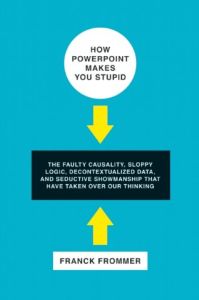Melden Sie sich bei getAbstract an, um die Zusammenfassung zu erhalten.

Melden Sie sich bei getAbstract an, um die Zusammenfassung zu erhalten.
Franck Frommer
How PowerPoint Makes You Stupid
The Faulty Causality, Sloppy Logic, Decontextualized Data, and Seductive Showmanship That Have Taken Over Our Thinking
The New Press, 2012
Was ist drin?
Is PowerPoint just a computer program or a detriment to discourse? Put the question on a slide and discuss.
Recommendation
Franck Frommer, an expert in the field of communications, has written a passionate book about – of all the unexpected topics – PowerPoint. He recognizes the program’s usefulness, technical excellence, flexibility and pervasive applicability, even as he criticizes its impact on the way people perceive, transmit and think about information. Part of his concern is that the program’s popular utility makes it ubiquitous and, thus, problematic. Though he may take his dismay a bit far when he holds PowerPoint solely responsible for the “dumbing down” of society, Frommer makes an interesting argument about the program’s effect. If you think PowerPoint – or any computer program – is totally harmless, think again. Frommer walks the reader through the history of PowerPoint and demonstrates how “PowerPoint thinking” has infiltrated business, education and government. He gets a little steamed up, and, while he doesn’t really tell you how to use this tool more effectively, he does offer an original line of thought. getAbstract suggests this book to business managers, human resources directors and communications personnel. You’ll still need PowerPoint to do all the things it is good at, and you’ll still use it, but you’ll think about it differently.
Summary
About the Author
After 12 years in journalism, Franck Frommer went to work in communications and technology. He originally wrote this book in French; George Holoch did the translation.


















Comment on this summary